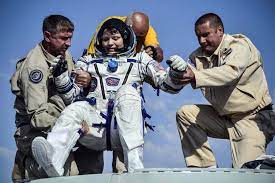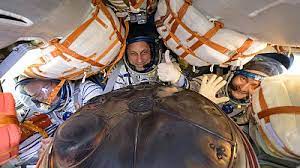Nasa astronaut return to Earth – A triumphant moment – 2023
Nasa astronaut return to Earth
Nasa astronaut return to Earth – In a remarkable space mission accomplishment, NASA astronauts Kayla Barron, Raja Chari, and Tom Marshburn, along with European Space Agency (ESA) astronaut Matthias Maurer, safely concluded their journey by making a controlled descent back to Earth.
The final leg of their adventure saw them splashing down into the ocean at 12:43 a.m. EDT.
As the astronauts’ spacecraft gently touched down in the water, the culmination of their incredible space voyage was met with anticipation and relief. SpaceX recovery vessels, diligently positioned in the area, swiftly sprang into action to retrieve both the spacecraft and the intrepid crew members.

The successful recovery marked a pivotal moment in this space odyssey, ensuring the safe return of these dedicated astronauts who had spent their mission exploring the cosmos.
Following their return to the welcoming embrace of solid ground, the astronauts are set to embark on the next phase of their journey: a flight back to NASA’s renowned Johnson Space Center, situated in Houston.
Follow Our Digiknowledge.co.in Page for Latest update about Bikes, Cars, Sports, Government Policy and many more.
There, they will undergo further debriefing, medical evaluations, and the necessary steps to reintegrate into life on Earth after their awe-inspiring venture into the great beyond.
The remarkable Crew-3 mission embarked on its journey on November 10, with a spectacular liftoff atop a Falcon 9 rocket from the historic launchpad at NASA’s Kennedy Space Center in Florida.
After approximately 24 hours in orbit, precisely on November 11, the Crew-3 spacecraft, known as “Endurance,” gracefully docked with the forward space station port of the Harmony module.
The docking was a pivotal moment in this mission, symbolizing the seamless integration of human spaceflight technology and international cooperation in the vast expanse of space. It marked the beginning of the astronauts’ remarkable stay aboard the International Space Station (ISS), where they conducted vital research and performed tasks essential for the station’s operation.

As the mission reached its conclusion, Nasa astronaut return to Earth prepared to bid farewell to the ISS and return to Earth. Undocking from the same Harmony module’s forward port at 1:05 a.m. on May 5, they commenced their journey homeward. This phase marked the beginning of their reentry and descent back to our planet, concluding their historic mission aboard the space station.
The Crew-3 mission by which Nasa astronaut return to Earth represented a significant leap forward in scientific exploration in the unique microgravity environment of space. Among its diverse array of groundbreaking experiments and investigations, several notable highlights stand out:
- Fiber Growth in Microgravity: Building upon previous research, Crew-3 continued to unravel the mysteries of fiber growth in the absence of gravity. Their work expanded our understanding of how materials behave in space, with potential applications in advanced materials science and manufacturing.
- Advanced Plant Growth Techniques: The mission pioneered hydroponic and aeroponic techniques, allowing plants to thrive without soil or traditional growth materials. This innovative approach not only furthers our knowledge of sustainable food production in space but also has implications for future long-duration space missions and terrestrial agriculture.
- Retina Imaging for Astronaut Health: Crew-3 conducted retina imaging as part of a groundbreaking study aimed at automating the detection of eye changes in astronauts during their space missions. This research contributes to our understanding of the effects of prolonged space travel on vision and overall astronaut health.

- Biological Indicator Technology: A notable demonstration involved cutting-edge technology that measures biological indicators related to disease and infection. This research holds the potential to revolutionize healthcare in space and on Earth, enabling rapid diagnosis and monitoring of health conditions.
- Crew Earth Observation: In keeping with a long-standing tradition, Crew-3 engaged in the Crew Earth Observation investigation. This initiative involved capturing hundreds of photographs of our planet from space, contributing valuable data to track natural disasters, climate changes, and other Earth-related phenomena. This project exemplifies the enduring commitment to understanding and safeguarding our home planet.
The astronauts of Crew-3 conducted these experiments and investigations with unwavering dedication, pushing the boundaries of human knowledge and contributing to the advancement of science, technology, and our understanding of life in space and on Earth. Their efforts will undoubtedly leave a lasting impact on future space exploration endeavors.
Crew-3’s mission is a pivotal component of NASA’s groundbreaking Commercial Crew Program. Following their safe return to Earth, this mission comes on the heels of another remarkable event in space exploration: the launch of NASA’s SpaceX Crew-4 mission.
The Crew-4 mission successfully docked with the International Space Station on April 27, marking the commencement of yet another exciting science expedition.
How do Nasa astronaut return to Earth from the International Space Station (ISS)?
NASA astronauts typically return to Earth from the ISS aboard a spacecraft, such as SpaceX’s Crew Dragon or Russia’s Soyuz. These spacecraft undergo a controlled descent and landing, often utilizing parachutes for a safe splashdown or landing.
How is the landing site for Nasa astronaut return to Earth determined?
The landing site is chosen based on a variety of factors, including weather conditions, recovery team readiness, and the spacecraft’s trajectory. Multiple potential landing sites are designated, and the final decision is made closer to the return date.
What is the medical evaluation process for Nasa astronaut return to Earth ?
Upon landing, astronauts undergo a series of medical evaluations to assess their physical condition. These evaluations help determine if any medical interventions or rehabilitation are needed.
What happens to the scientific data and experiments conducted in space?
Scientific data and experiments conducted in space are carefully collected, stored, and transmitted back to Earth. Researchers analyze this data to gain insights into various scientific phenomena and space-related effects on the human body.
How does NASA coordinate with international space agencies for astronaut returns?
NASA collaborates closely with international partners, such as Russia’s Roscosmos and the European Space Agency (ESA), to ensure seamless operations during astronaut returns. This includes sharing resources and expertise for recovery operations.
Do astronauts experience any psychological challenges during their return to Earth?
Some astronauts report emotional and psychological challenges during the transition from the weightless environment of space to Earth’s gravity. This can include feelings of dizziness, disorientation, and even a sense of “reverse culture shock.”




